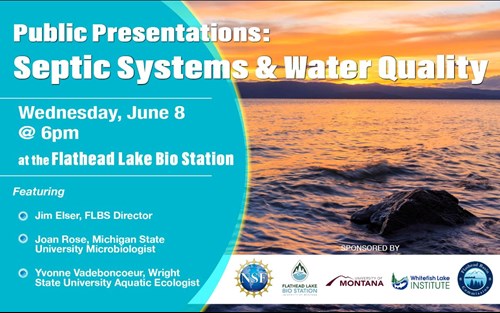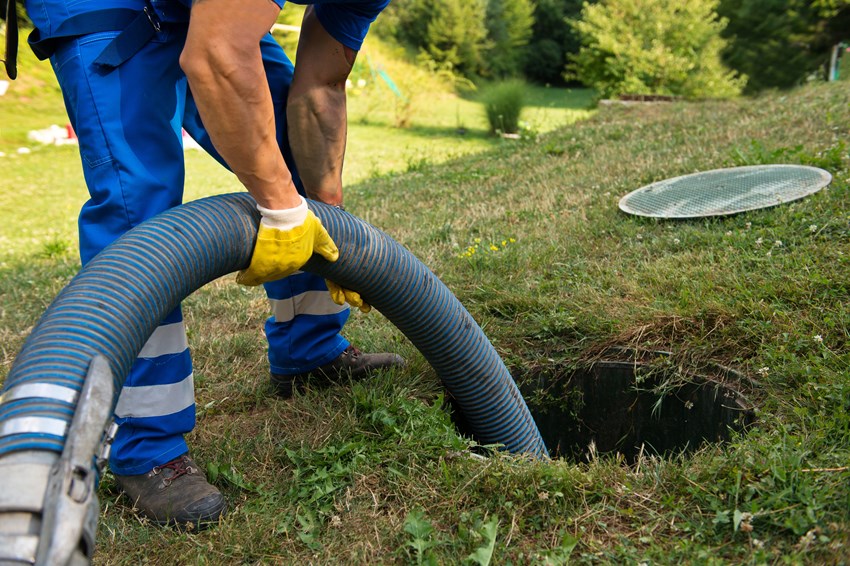Wait or mitigate?
Researchers put on a workshop to address septic system issues in the Flathead Watershed
By University of Montana Environmental Science and Natural Resource Journalism Graduate Student Keely Larson
When the research team comprised of members from the Flathead Lake Biological Station and the University of Montana gets together, the poop jokes are surprisingly few. Starting on June 8, these researchers will lead a workshop at the Flathead Lake Biological Station focused on septic systems and their potential impacts on water quality in the Flathead Watershed.
The Flathead Basin Commission, created by the Montana state legislature in 1983 to monitor and protect the water quality and natural resources of the Flathead Watershed, recently identified septic leachate, which comes from home wastewater treatment systems, as a top priority threat to the region’s world-renowned water quality. Working with the Flathead Basin Commission, this workshop will focus on challenges and solutions related to septic leachate from septic systems around Flathead Lake and its watershed.
The workshop is broken into two parts. On the evening of June 8, there are presentations open to the public, and then the following two days will consist of invitation-only discussions and break-out groups.
Natural scientists, social scientists, resource managers, and elected officials were invited to learn about the history and current status of septic system legislation and regulations in Montana, to discuss the potential for technology to aid in identifying improperly functioning septic systems and resulting harmful algal blooms, and to discuss how to bolster people’s awareness of this problem. Over the course of the workshop, participants will consider what more is needed to tackle septic system issues and why it is a challenging problem to solve.
The workshop is funded by a Smart and Connected Communities initiative offered by the National Science Foundation (NSF). This NSF grant is addressing the social, scientific, and economic factors related to septic systems.
Septic leachate is considered a nonpoint source pollutant. It doesn’t come from one specific spot, like an oil tanker spilling oil into the ocean or a pipe spewing pollution from a factory, but from multiple dispersed locations, like the septic systems around Flathead Lake. Nutrient and biological pollutants like nitrogen and fecal coliform are indicators of septic system contamination and are harmful to both water quality and human health.
As seen around many Montana lakes, the concentration and age of septic systems bordering Flathead Lake is concerning, according to researchers. Out of about 27,000 septic systems in Flathead County, a third are older than 30 years, according to Mike Koopal, one of the researchers on the team and Executive Director of Whitefish Lake Institute. The average functional life of a septic system is 20 to 25 years.
There is no strong regulation of septic system maintenance or upgrades at the state or county level. Once installed, responsibility falls on homeowners to understand that they have a septic system, and to keep up with pumping every five years, periodic inspections, and 20-year upgrades.
With Flathead County identified as the fastest growing county in Montana, Koopal knows the septic issues will get worse. It seems like something that can be tabled, Koopal said, but if addressed now, the lake won’t have to be at the point of no return when policies are made.
The point of the workshop is to put together a toolbox that stakeholders in the Flathead Watershed can use to work on the septic system problem. More so, the idea is that over the two days, the tools themselves will be created.
Speakers will present to the public on June 8 about their experiences studying septic leachate. These speakers include Bio Station Director Jim Elser, who will present on wastewater treatment plant technology; Joan Rose, a microbiologist from Michigan State University who studies the public health impact of failing septic systems; and Yvonne Vadeboncoeur, an aquatic ecologist from Wright State University who studies algal blooms in lakes.

Presentations will begin on Wednesday, June 8 at 6pm at the Flathead Lake Biological Station. Hors d’oeuvres will be provided prior to the presentations at 5:30pm, and there is no fee to attend.
For those who are unable to attend in person, or would like to listen in to the presentations from the comfort of their home, a Zoom Link is available at: https://flbs.umt.edu/urls/septic
Algae blooms on Flathead Lake are infrequent, but they are becoming more common on other rivers and lakes in Montana. Some fuzzy green spots, also called filamentous algal blooms, show up on the shoreline first. The Flathead Lake Biological Station regularly tests the lake’s water out in the water column, but not frequently in the nearshore environment due to limited resources where the first indicators of septic leachate contamination arise.
By putting on this workshop, researchers are trying to take a proactive stance against a problem that hasn’t happened yet. Sarah Halvorson, a UM geography professor and researcher on the team, explained that population growth in the Flathead Watershed and aging septic systems are causes for concern, even if that concern is not immediately visible or identifiable.
“The reason why we don’t see big impacts on water quality is in part because of the internal dynamics of the lake,” Halvorson said. Every two years, all the water of Flathead Lake gets replaced, a natural cycle, enforcing an adage Halvorson recalled — the solution to pollution is dilution.
Public presentations are on June 8 at the Flathead Lake Biological Station. Hors d’oeuvres will be provided at 5:30 p.m. and talks will begin at 6 p.m.


